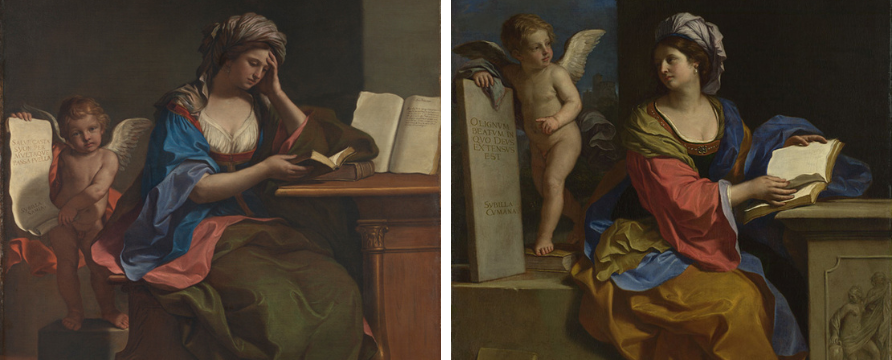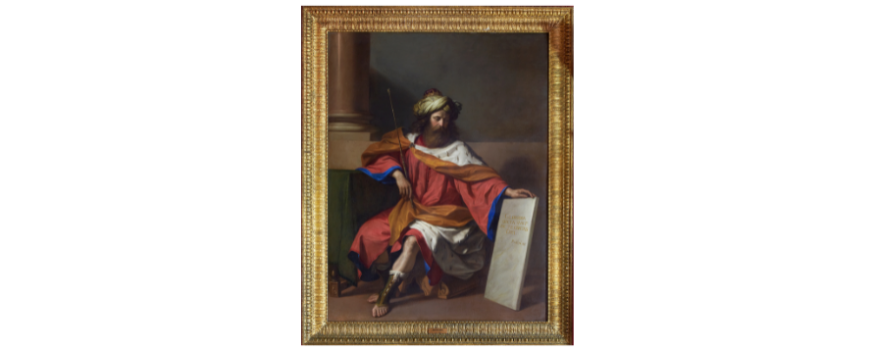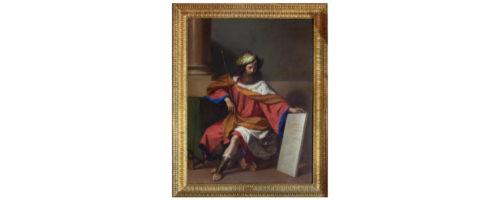King David, Giovanni Francesco Barbieri (1651) / Credit: Waddesdon Image Library
Five works of art by renowned Bolognese painter Giovanni Francesco Barbieri (1591-1666), known as Guercino, will go on public display for the first time as part of a historic exhibition at Waddesdon Manor from 20 March to October 2024.
The exhibition spotlights one of the great painters of 17th century Italy, bringing together King David (1651) from Waddesdon’s collection and Guercino’s depiction of three sibyls – female prophets from classical antiquity – on loan from the National Gallery, London and His Majesty The King from the Royal Collection. It is also the first time ever that Guercino’s recently rediscovered early masterpiece Moses (c. 1618–19) will go on public display.
Now at Waddesdon Manor, King David was originally intended for the palazzo in Cesena, near Bologna, of the Italian nobleman Giuseppe Locatelli, with The Cumaean Sibyl with a Putto (1651, National Gallery) commissioned to be its pendant. However, when Prince Mattias de’ Medici saw the Sibyl in Guercino’s studio, he liked it so much that he insisted that he acquire it. As something of a consolation for Locatelli, the artist painted The Samian Sibyl (1651, National Gallery), as a replacement.
They will be joined in Waddesdon Manor’s grand but intimate Red Ante Room by the Royal Collection’s half-length Libyan Sibyl, (also 1651) which reinforces the appeal of the sibyl as a model of female authority to Baroque artists.

The Cumaean Sibyl with a Putto, Giovanni Francesco Barbieri (1651) / Credit: Waddesdon Image Library
By bringing the quartet of paintings together, for what is believed to be the very first time in over 350 years since they were painted, visitors will be able to see, close up, Guercino’s brilliant handling of paint to depict silk, flesh and ermine, paper, wood and stone, while conjuring up ideas about inspiration and contemplation, sight and foresight, poetry and prophecy.
Another historic aspect to this display is the unveiling of Guercino’s long lost depiction of the Old Testament figure Moses. Moses is datable to c. 1618–19 and although it is not known exactly when or for whom the painting was commissioned, by 1624 Moses was in the possession of Cardinal Alessandro d’Este (1568–1624) in Rome. It subsequently entered his family’s renowned ducal collections in Modena and remained there until the Napoleonic era, when all trace of the painting was lost. It is possible that the painting was relocated to France where, at the end of the 18th century admiration for Guercino was at its height, with his works being as sought after on the Parisian art market as those by Rembrandt.
Until its discovery in France in 2022, the painting was known only through 17th century painted copies, a drawing and engravings, all of which demonstrate the work’s fame well beyond the confines of the Duchy of Modena.
Now visitors to Waddesdon Manor will be able to marvel at Guercino’s representation of Moses turning his eyes upwards and raising his hands in a gesture of praise as he communicates directly with God. The recent discovery of Moses (c. 1618–19) constitutes one of the most important additions to Guercino’s body of work in recent years and adds to our understanding of his early maturity, a period considered by many to be his greatest for the dynamism, vigour and spontaneity of his painting.
Pippa Shirley, Director of Waddesdon said, “We are so excited to be able to display this group of paintings in a first for Guercino at Waddesdon, and to put a new acquisition on display also for the first time. Without doubt the most significant addition the Rothschild Foundation has made to the collections since Jean-Siméon Chardin’s Boy building a house of cards in 2008, the arrival of Moses felt irresistible because it appeared just as we were planning this exhibition, with the great painting of King David at its heart. Bringing the two together with the group of sibyls creates an incredibly rich context of contrast and comparison, allowing us an insight into the arc of Guercino’s extraordinary career. The sibyls in particular are emblematic of his work, as he returned to the subject of these mysterious and powerful female seers again and again. I hope that they will create the same fascination for our visitors, because the way in which all of these paintings embody ideas of faith and foresight, power and prophesy and how the past relates to the future is as relevant to us now as it was in the uncertain 17th century world. We are immensely grateful to the National Gallery and His Majesty the King and the Royal Collection for so generously enabling this potent encounter.”
Click here to discover more about this exhibition at Waddesdon Manor.










